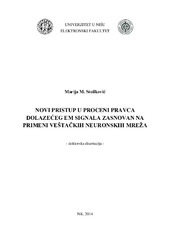Приказ основних података о дисертацији
Novi pristup u proceni pravca dolazećeg EM signala zasnovan na primeni veštačkih neuronskih mreža
| dc.contributor.advisor | Milovanović, Branislav | |
| dc.contributor.other | Dončov, Nebojša | |
| dc.contributor.other | Marković, Vera | |
| dc.contributor.other | Jokanović, Branka | |
| dc.contributor.other | Maleš-Ilić, Nataša | |
| dc.creator | Stoilković, Marija M. | |
| dc.date.accessioned | 2017-02-08T10:31:40Z | |
| dc.date.available | 2017-02-08T10:31:40Z | |
| dc.date.available | 2020-07-03T16:02:11Z | |
| dc.date.issued | 2015-06-26 | |
| dc.identifier.uri | https://nardus.mpn.gov.rs/handle/123456789/7475 | |
| dc.identifier.uri | http://eteze.ni.ac.rs/application/showtheses?thesesId=4547 | |
| dc.identifier.uri | https://fedorani.ni.ac.rs/fedora/get/o:1251/bdef:Content/download | |
| dc.identifier.uri | http://vbs.rs/scripts/cobiss?command=DISPLAY&base=70052&RID=533868182 | |
| dc.description.abstract | Direction of Arrival (DOA) estimation of electromagnetic (EM) signals strongly depends on characteristics of received signals, configuration and physical layout of a receiving antenna array and environmental conditions. DOA algorithms have crucial role in adaptive antenna systems where used to provide better reception of desired signals and to suppress interference. Consequently, they have significant impact on system capacity. So far, numerous DOA algorithms have been developed assuming different configurations of antenna arrays and characteristics of EM signals. The main problem that appears when these algorithms are applied in practice is that a compromise between accuracy of the results and speed of calculation must be made. For that reason, a method for DOA estimation based on Artificial Neural Networks (ANNs) is applied in this dissertation. The main contribution of this work is development of neural models for the efficient and accurate DOA estimation of EM signals both in azimuth and elevation. Assuming rectangular antenna array geometry at the receiver, neural models for 2D DOA estimation of uncorrelated and coherent signals are developed. It is shown that applying a hierarchical neural model can greatly affect the accuracy of DOA estimates when compared to standard superresolution algorithms. To develop neural models, the observed space is divided into sectors in azimuth and elevation. The neural networks in the first stage of the model are trained to detect presence of electromagnetic sources, while the networks in the second stage are trained to provide precise DOA estimates. The appropriately trained hierarchical model, composed of smaller neural networks, can be used for accurate DOA estimation in azimuth and elevation. As follows, time to train separate networks is drastically reduced as different training sets are used for the networks in the detection and estimation stage. The proposed models are very efficient, able to provide DOA estimates in a matter of seconds and very suitable for real time application. Performances of the models are experimentally verified. Besides, the results are compared with the results of the standard algorithm for DOA estimation. Advantages of the proposed models are accuracy of DOA estimates and speed of calculation. In addition, neural models can be trained to account for some other characteristics of EM signals (number of signals, signal to noise ratio, correlation between signals), physical characteristics of the receiving array and environmental conditions. Influence of signal to noise ratio (SNR) on the performance of neural models, aimed for DOA estimation of signals in azimuth plane, is also investigated. It is shown that SNR strongly affects the accuracy of DOA estimates, and as such should be involved as an additional parameter in the process of training of a neural network. Further, detection of correlated signals is investigated assuming circular antenna array geometry. In this case, neural models are developed for different number of signals and correlation between them. In this dissertation, application of artificial neural networks in DOA estimation of radar MIMO (Multiple Input Multiple Output) – OFDM (Orthogonal Frequency Division Multiplexing) signals is presented. A neural model is optimized and its performance is compared to conventional algorithm regarding accuracy and time consumption. | en |
| dc.format | application/pdf | |
| dc.language | sr | |
| dc.publisher | Универзитет у Нишу, Електронски факултет | sr |
| dc.relation | info:eu-repo/grantAgreement/MESTD/Technological Development (TD or TR)/32052/RS// | |
| dc.rights | openAccess | en |
| dc.rights.uri | https://creativecommons.org/licenses/by-nc/4.0/ | |
| dc.source | Универзитет у Нишу | sr |
| dc.subject | antenski nizovi | sr |
| dc.subject | antenna arrays | en |
| dc.subject | MUSIC algoritam | sr |
| dc.subject | procena pravca EM signala | sr |
| dc.subject | prostorna kovarijansna matrica | sr |
| dc.subject | prostorna obrada signala | sr |
| dc.subject | veštačke neuronske mreže | sr |
| dc.subject | artificial neural networks | en |
| dc.subject | DOA estimation | en |
| dc.subject | MUSIC algorithm | en |
| dc.subject | spatial covariance matrix | en |
| dc.subject | spatial signal processing | en |
| dc.title | Novi pristup u proceni pravca dolazećeg EM signala zasnovan na primeni veštačkih neuronskih mreža | sr |
| dc.type | doctoralThesis | en |
| dc.rights.license | BY-NC | |
| dcterms.abstract | Миловановић, Бранислав; Дончов, Небојша; Марковић, Вера; Јокановић, Бранка; Малеш-Илић, Наташа; Стоилковић, Марија М.; Нови приступ у процени правца долазећег ЕМ сигнала заснован на примени вештачких неуронских мрежа; Нови приступ у процени правца долазећег ЕМ сигнала заснован на примени вештачких неуронских мрежа; | |
| dc.identifier.fulltext | https://nardus.mpn.gov.rs/bitstream/id/52175/Disertacija7496.pdf | |
| dc.identifier.fulltext | http://nardus.mpn.gov.rs/bitstream/id/52175/Disertacija7496.pdf | |
| dc.identifier.rcub | https://hdl.handle.net/21.15107/rcub_nardus_7475 |


